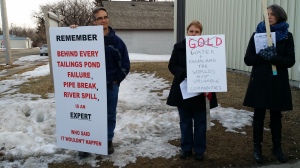Celebrate and Protect our Clean Water on World Water Day
March 22 is World Water Day
Here in Corman Park we have an extremely clean groundwater source – the Dalmeny Aquifer. Let’s celebrate and protect it now, and for future generations.
Email the RM Councillors today to let them know how you feel about keeping our aquifer clean – and ask them to protect it by voting NO to rezoning land for Fortune Minerals’ dangerous metals processing plant on March 25. Click here for the Councillors’ email addresses.
The First Reading vote on the rezoning application will be on Monday Mar 25th at 1:00 PM at the RM office at 111 Pinehouse Drive, Saskatoon. (click for map) Please attend if you can!
Water Quality
Fortune Minerals’ Addendum to their Environmental Impact Assessment Statement, September 2013 (page 11) provides a chart of the process brine characteristics. The brine is the solution that would be injected into a deep aquifer via injection wells that would be drilled through the Dalmeny Aquifer. The chart below provides comparison of Fortune Minerals brine, Saskatchewan’s Drinking Water Quality Standards and Objectives and the most recent Dalmeny Aquifer water quality report from the Saskatchewan Water Security Agency. All amounts are measured in mg/L, which is the same as parts per million.
Fortune Minerals’ brine characterization is based on the project plans in place when they submitted their application for Environmental Impact Assessment in 2011. It did not include any analysis of the chemistry that might result from processing other materials, as they have indicated they might do as a way to extend the life of the proposed plant or increase its economic viability. Their proposed solid waste facility is larger than would be needed for processing the expected output of the NICO mine. This suggests that additional processing is planned and therefore brine chemistry would be different and its volume would be more than what was stated in their environmental impact assessment documents.
| Chemical | Fortune Minerals Brine | Saskatchewan Drinking water standards and objectives | Dalmeny Aquifer Water Quality per SWA, 2005 | Known or suspected to cause adverse effects on health |
| Chloride (Cl) | 2304 | 250 | 10 | |
| Sulphate (SO4) | 36032 | 500 | 1160 | Diarrhoea, risk of dehydration in infants and elderly |
| Bicarbonate (HCO3) | 248 | 800 | 805 | |
| Aluminum (Al) | 0.5 | 0.0012 | ||
| Arsenic (As) | 1.8 | 0.025 | 0.0004 | Cancer; neurological, skin and vascular problems |
| Bismuth (Bi) | 1.7 | |||
| Calcium (Ca) | 166 | 382 | ||
| Cadmium (Cd) | 0.04 | 0.005 | < 0.0005 | Kidney damage, bone problems |
| Cobalt (Co) | < 1 | < 0.0013 | Probable carcinogen | |
| Copper (Cu) | 0.9 | 1.0 | < 0.0002 | |
| Iron (Fe) | 3.8 | 0.3 | 9.4 | |
| Magnesium (Mg) | 1631 | 200 | 172 | |
| Manganese (Mn) | 2.5 | 0.05 | 0.22 | Neurological damage at high levels |
| Sodium (Na) | 15203 | 300 | 104 | |
| Nickel (Ni) | 1.0 | 0.0004 | ||
| Lead (Pb) | 0.1 | 0.01 | < 0.0001 | Central nervous system damage, probable carcinogen, multiple harms to infants and children |
| Zinc (Zn) | 0.7 | 5 | 0.005 |
Click on any of the tags below for more information about how the Fortune Minerals project could harm our precious aquifer.
Guardians of Eternity
Historian and filmmaker Ron Harpelle of Lakehead University is working with independent filmmakers Kelly Saxberg (of Sheba Films) and France Benoit to make a documentary film about the arsenic issue at Giant mine. Giant Mine is an old gold mine in Yellowknife NWT that was abandoned by the company and left for the federal government to manage. The mine is full of toxic arsenic waste that must be kept isolated from the environment forever.
Here is an excerpt from the film, Guardians of Eternity. The woman interviewed in this clip speaks about the immense task and responsibility of warning all future generations of the danger. If Fortune Minerals is allowed to dump its arsenic and asbestos laden waste in Corman Park how will we protect future generations?
For more about the Giant Mine project see The Toxic Legacies Project
Photos from March 19 Public Meeting
On March 19, 2014 Fortune Minerals held a public meeting in Langham.
Clark’s Crossing Gazette reported on the meeting in the March 21 edition. Read Forum tackles concerns about Fortune Minerals refinery near Langham.
Here are some photos from that event.
Scientific study shows Dalmeny aquifer vulnerable to contamination
A study published in a scientific journal in 1986 tells that the thick underground layer of clay (called an “aquitard”) between the ground surface and the Dalmeny aquifer is full of vertical and horizontal cracks (fractures) and can conduct liquids 100 times faster than the same kind of clay (called “till”) would if it was not cracked. The Fortune Minerals EIS made the unfounded assumption that the clay layer was not cracked and thus concluded it would take 50o years for contaminants to reach the aquifer. This study tells us that contaminants would move 100 times faster — that is, the arsenic from the FM waste would reach the drinking water in 50 years — make that 5 years! This study also shows that it has taken less than 50 years for surface water to reach the aquifer because in 1985 they detected a certain amount of tritium (a radioactive form of water that was only released into the environment since 1945) in the Dalmeny aquifer.
Below, see a link to the full 12-page article, the publisher and author information, the abstract (summary) and a key paragraph from the study’s conclusion.
Published in Canadian Geotechnical Journal, 1986, 23(2): 229-240, 10.1139/t86-032
Link to full article http://www.nrcresearchpress.com/doi/pdf/10.1139/t86-032
Fracture permeability and groundwater flow in clayey till near Saskatoon, Saskatchewan
C. KENT KELLER
Department of Earth Sciences, University of Waterloo, Waterloo, Ont., Canada N2L 3GI
GARTH VAN DER KAMP
Sedimentary Resources, Saskatchewan Research Council, 15 Innovation Boulevard, Saskatoon, Sask., Canada S7N 2×8
AND
JOHN A. CHERRY
Department of Earth Sciences, University of Waterloo, Waterloo, Ont., CanadaN2L3GI
Received July 8, 1985
Accepted December 23, 1985
Field and laboratory studies of a clayey unweathered glacial till have shown that its bulk permeability exceeds its matrix permeability by two orders of magnitude [100 times]. Such findings are common for weathered till but are rare for unweathered till, and have important implications for groundwater recharge and contaminant transport. The till in question is 6 m thick and appears to be unweathered and unfractured. It is overlain by 12m of weathered and highly fractured till. Results of consolidation tests on the unweathered till indicate a mean vertical hydraulic conductivity of 3.5 x 10-” m.s-‘ and a mean specific storage of 1.3 X m-I. Results of slug tests yield a horizontal hydraulic conductivity of about 5 x mas-‘. Drawdowns in the till in response to pumping from the aquifer below indicate a vertical hydraulic diffusivity of 4.5 x 10-5m2-s-‘. The slug test results combined with specific storage results from consolidation tests indicate a similar value for horizontal hydraulic diffusivity of 4 X m2-s-‘. Geochemical patterns, tritium data, and measured seepage fluxes from an ephemeral pond also indicate that the vertical conductivity of the unweathered till is much higher than the value obtained from the consolidation tests. The data thus show that the unweathered till has significant vertical and horizontal fracture permeability.
Key words: till, permeability, fracture, groundwater recharge, contaminant transport.
5. Conclusions
The results of this study of the Dalmeny site demonstrate that a clayey glacial till, which exists at considerable depth below the water table and which exhibits no visual evidence of weathering or fractures in vertical core samples, has hydraulic properties attributable to a permeable fracture network. The bulk vertical and horizontal hydraulic conductivity of the till is approximately 5 X lop9m-s-‘; this is two orders of magnitude greater than the hydraulic conductivity of the till matrix. The Dalmeny site is flat and is located far from river valleys that could cause local stress anomalies in the till. Thus the hydraulically conductive nature of the unweathered till at this site may be characteristic of many other unweathered clayey aquitards in the Northern Interior Plains Region. An important implication of this study is that contaminants, which may enter the till at ground surface from waste-disposal activities, agricultural application of chemicals, or chemical spills, may not be effectively isolated from the aquifer by zones of unweathered clayey till. The fractures in the weathered and unweathered till may provide significant pathways for downward contaminant migration.
Medical Journal Article about Health Effects of Arsenic in Drinking Water
The Broad Scope of Health Effects from Chronic Arsenic Exposure: Update on a Worldwide Public Health Problem
Abstract
Background: Concerns for arsenic exposure are not limited to toxic waste sites and massive poisoning events. Chronic exposure continues to be a major public health problem worldwide, affecting hundreds of millions of persons.
Objectives: We reviewed recent information on worldwide concerns for arsenic exposures and public health to heighten awareness of the current scope of arsenic exposure and health outcomes and the importance of reducing exposure, particularly during pregnancy and early life.
Methods: We synthesized the large body of current research pertaining to arsenic exposure and health outcomes with an emphasis on recent publications.
Discussion: Locations of high arsenic exposure via drinking water span from Bangladesh, Chile, and Taiwan to the United States. The U.S. Environmental Protection Agency maximum contaminant level (MCL) in drinking water is 10 µg/L; however, concentrations of > 3,000 µg/L have been found in wells in the United States. In addition, exposure through diet is of growing concern. Knowledge of the scope of arsenic-associated health effects has broadened; arsenic leaves essentially no bodily system untouched. Arsenic is a known carcinogen associated with skin, lung, bladder, kidney, and liver cancer. Dermatological, developmental, neurological, respiratory, cardiovascular, immunological, and endocrine effects are also evident. Most remarkably, early-life exposure may be related to increased risks for several types of cancer and other diseases during adulthood.
Conclusions: These data call for heightened awareness of arsenic-related pathologies in broader contexts than previously perceived. Testing foods and drinking water for arsenic, including individual private wells, should be a top priority to reduce exposure, particularly for pregnant women and children, given the potential for life-long effects of developmental exposure.












 1
1
Don’t miss these Recent Comments: click to view